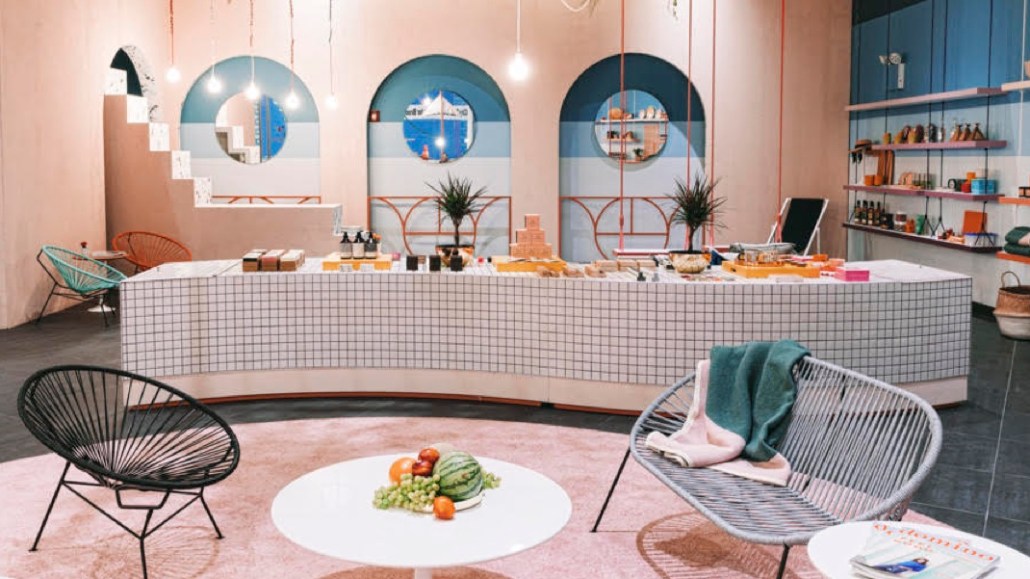Publishers chase experiential budgets with holiday pop-up shops

To help advertisers cut through a blizzard of marketing and advertising during the holiday season, publishers are luring them with pop-up shops and events.
A number of lifestyle publishers, including Clique, PopSugar and Domino, are opening holiday-themed pop-up shops or events that will run through the end of 2017. On Dec. 1, the Clique-owned beauty site Byrdie will open the Byrdie Beauty Lab, a 2,000-square-foot shop where people can buy beauty products Byrdie created with Nordstrom and take free beauty classes taught by big-name makeup artists.
A few blocks away, Domino will open up a 3,000-square-foot pop-up shop in SoHo with Home Depot where people can attend free workshops and buy products chosen by Domino editors. On Dec. 9, PopSugar will open Deck the Hauls, an Old Navy-supported installation at St. Ann’s Warehouse in Brooklyn, where custom gift boxes will be sold.
These events and others like them are part of publishers’ latest effort to respond to companies’ need to show their marketing dollars are driving people to purchase and demand for fewer advertising programs that deliver a greater impact.
“Experiential marketing has always been part of our offering, but we’ve seen a significant uptick in the demand for bespoke events,” said Geoff Schiller, PopSugar chief revenue officer. “It’s a response to the need to do things that are fewer, bigger, better.”
Experiences and pop-up shops also respond to the unprecedented pressure that retailers face from Amazon and other digital retailers. An estimated 8,000 retail store locations will close this year, according to Credit Suisse, leaving retailers desperate for ways to reach consumers.
“Pop-up shops used to be all branding and PR,” said Gabriela Neves, a partner at the experiential agency Factory 360. “But as it started to grow, brands have begun asking, ‘Why can’t we sell?’”
Until recently, pop-ups have been the domain of agencies and production companies. But publishers can create editorial content to extend and amplify the reach of the event, which gives them an edge in going after experiential budgets.
Domino, for example, will use workshops with designer Cynthia Rowley and Instagrammer Patrick Janelle at its pop-up shop to generate editorial content. Those articles, which mention brands, can be supplemented with display advertising, as Domino did with American Express around a pop-up shop it had in the Hamptons this past summer.
Similarly, PopSugar’s Hauls program is an extension of an advertising program Old Navy bought from the publisher. The program includes mentions and placement in PopSugar’s live gift guides, purchase links added to videos and social media promotion.
That mix of brand inclusion, plus trackable links that close the loop on consumer purchases, appeal to retailers, which now represent PopSugar’s biggest category of advertisers. “[Consumer product goods] brands have gone programmatic,” Schiller said. “Retail brands want to do more branded stuff.”
Image via Domino, from a 2017 pop-up in Brooklyn
More in Media

Media Briefing: Publishers who bet on events and franchises this year are reaping the rewards
Tentpole events and franchises are helping publishers lock in advertising revenue.

With Firefly Image 3, Adobe aims to integrate more AI tools for various apps
New tools let people make images in seconds, create image backgrounds, replacing parts of an image and use reference images to create with AI.

Publishers revamp their newsletter offerings to engage audiences amid threat of AI and declining referral traffic
Publishers like Axios, Eater, the Guardian, theSkimm and Snopes are either growing or revamping their newsletter offerings to engage audiences as a wave of generative AI advancements increases the need for original content and referral traffic declines push publishers to find alternative ways to reach readers.







